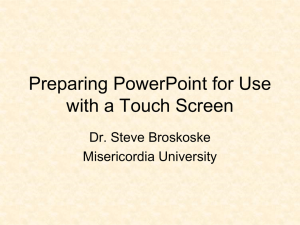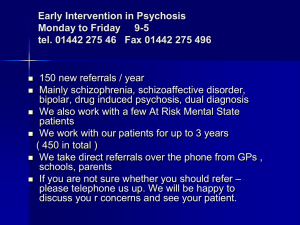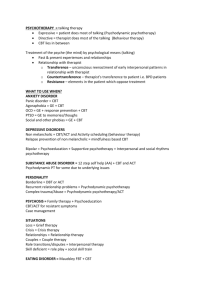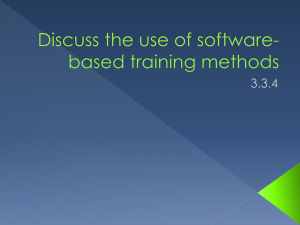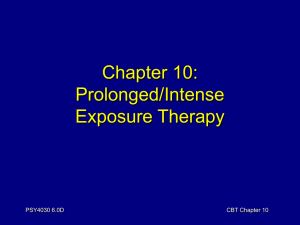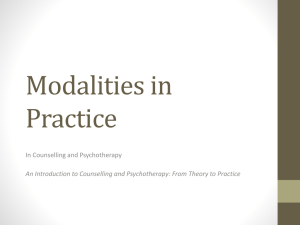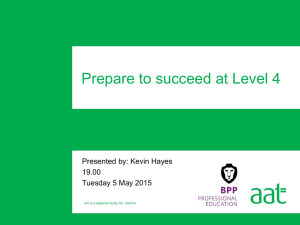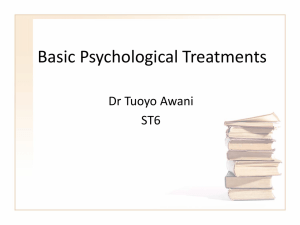Psychosis: Counseling the Delusional Patient
advertisement
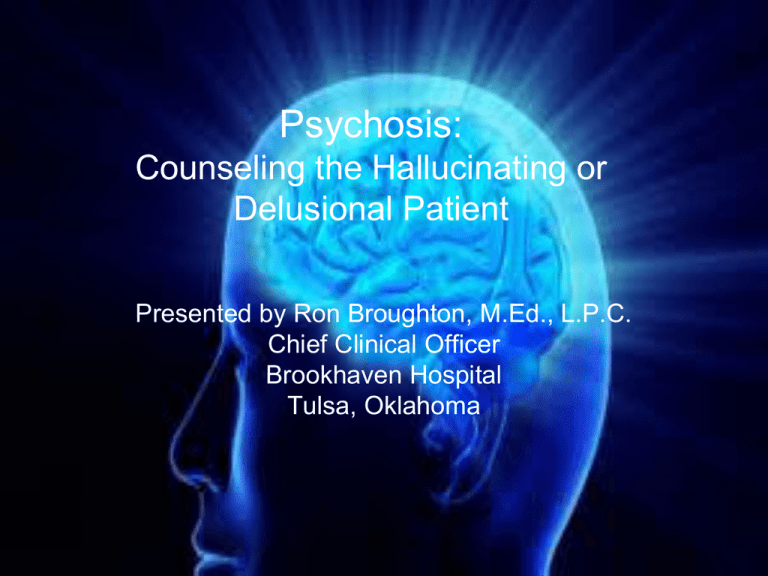
Psychosis: Counseling the Hallucinating or Delusional Patient Presented by Ron Broughton, M.Ed., L.P.C. Chief Clinical Officer Brookhaven Hospital Tulsa, Oklahoma Objectives 1. Overview of medications & efficacy 2. Historical examination of the role of psychotherapy with psychotic patients 3. Review recent research of CT/CBT 4. Learn specific therapy strategies for psychosis 5. Overview the of ABC model Definitions • Delusion: a false belief based on an incorrect inference about external reality that is firmly sustained despite what almost everyone else believes, and despite what constitutes incontrovertible and obvious proof or evidence to the contrary. • Hallucination: a sensory perception that has the compelling sense of reality of a true perception but that occurs without external stimulation of the relevant sensory organ • Is it inside or outside? Interestingly, the DSM-IV “makes no distinction as to whether the source of the voices is perceived as being inside or outside of the head.” Charlie Brown’s View 2010 $16 billion on antipsychotics Reduce positive and improve negative symptoms Less overall side-effects Examples: Clozaril, Risperdal, Zyprexa, Seroquel, Geodon, Abilify, Saphris, Fanapt, Latuda & Invega 25-50% Still experience symptoms May facilitate CT & CBT Research on Psychotherapy and Psychosis Three Recent Eras Psychotherapy 1960-1975 Medication vs. Therapy Medication Superior Focus On Problem Solving Experienced Therapists Better Outcomes* Psychotherapy 1980-1995 Compares Forms of Therapy Intensive = no advantage? Supportive & insight less meaningful *Strong alliance = better med compliance & outcome The Early Theme 1. 2. 3. 4. Psychodynamic approaches not effective Strong therapeutic rapport Personal therapy more effective Experienced clinician + individualized approach = better outcome An Evolution Begins Creativity is a drug I cannot live without. --Cecil B. De Mille Evolvement in the Late 90’s The Late 90’s Results Personal Therapy Experienced Clinician CBT Emphasis Positive Outcome Compared to supportive & psychoeducational treatment Don’t Forget Your Favorite College Course CBT Research & Hallucinations Reduces & decreases severity CBT Research & Hallucinations Increases quality of life CBT Research & Hallucinations CBT Family Therapy Integrative Approach CBT Research & Hallucinations Overall, CBT IMPACTS Hallucinations CBT Research & Delusions Studies Have Mixed Results CBT Research & Delusions • Some no effect until follow-up • Early decrease, not @ follow-up • Others: • 1/3 with decrease in conviction, preoccupation & anxiety • 1/3 No change • 1/3 In between Client Satisfaction Was treatment positive/helpful? •CBT = 70% “Yes, definitely” •ST = 37% •TAU = 30% Reason unclear, perhaps the therapeutic relationship? Strategies Strategies Establish a strong therapeutic rapport Strategies 1. Stress reduction 2. Relaxation techniques to stabilize 3. Systematic desensitization to stabilize 4. 5,4,3,2,1 to stabilize 5. Normalize the experience 6. Do Not use “delusion, hallucination, psychosis” 7. Know the belief well Strategies 8. Verbal challenge—the evidence 9. Voice logs 10. Client write out delusional content 11. Evidence logs 12. Change topic if client agitated 13. Relapse prevention plan Therapist Role—Some Tips Avoid waiting for the “meds to kick in” Be reliable, predictable & dependable Simple, honest accurate communication Have a healthy curiosity—reflection & restatement of content 5. Walk in the delusion, don’t collude with it 6. Restrict use of silence, or watch the eyes 7. If agitated, go to a neutral topic 1. 2. 3. 4. The ABC Model for Psychosis The Philosophy Noumenon An object as it is in itself, independent of the mind. The Philosophy Our reality is interpreted through our senses & beliefs, The “B” of the ABC Model Delusions on a Continuum Less Normal More All of us fall on the continuum. 5 Principles of the ABC Model 1. All clinical problems are C’s. 2. Problems arise from B’s not A’s. 3. There are predictable connections between B’s and C’s. 4. Core B’s arise from early experiences. 5. Weakening beliefs weakens associated distress & disturbance. Eight Basic Steps 1. 2. 3. 4. Client defines a problem Assess A or C Assess the one that remains Connect A to C & determine that is the clients primary worry 5. Assess beliefs, inferences & evaluations Eight Basic Steps 6. Formulation: Show the B-C connection Offer a developmental formulation 7. Set client’s goals & consider his options – – – – Avoid or escape Do nothing They can change them in some way Reduce by changing core beliefs Eight Basic Steps 8. Challenge beliefs Disputing and testing inferences Disputing and testing evaluations Note: this is sequence of conceptual steps, not of technical ones. Lengthy & dynamic process. Case Study #1 1. Delusional set Excessive religiosity Minimal ADL’s Reading the Bible and prayer only 2. Interventions Assessed A’s Assessed C’s Assessed B’s (inferences, evaluation & interpretation) Challenged B’s Family therapy Case Study #2 1. Indeterminate delusional set Highly intelligent Mathematics wiz “Word salad” 2. Interventions Assessed A’s Assessed C’s Unable to assess B’s Focused on health & safety Review 1. Brief overview of medications & efficacy 2. Historical examination of the role of psychotherapy with psychotic patients 3. Review recent research of CT/CBT for psychosis 4. Learn specific therapy strategies for psychosis 5. Overview the ABC model Some Conclusions 1. 2. 3. 4. 5. Therapeutic work lengthy Rapport is essential Requires patience and empathy DO NOT try to convince client Use Socratic dialogue—client draws on his own experience & doubt 6. ABC model and schema therapy Questions? Thank You!


